|
|
|
|
|
|
|
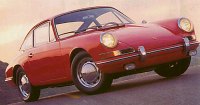 History started here - the original 2-litre car. No one would have estimated its success in the following 34 years. Spec ; Report |
|
|
|
Since 911 was well dearer than the 356, it was no way to replace the latter. As a result, Porsche created a cheaper version named 912 by installing 356's 1600 flat-4 engine. Nevertheless, this car never achieved much sales success. |
|
|
|
 Targa is Porsche's word. In our language is "removable hard top". The early Targa had soft rear window instead of the glass one shown in this '68 model. |
|
|
|
Porsche started to differentiate 911 into 3 versions with different character - 911 was the normal version (to be renamed to 911 L later and then 911 E), 911 S was the sport version with 160 hp (due to higher compression ratio and larger valves), alloy wheels and vent. brake discs.... Spec |
|
|
|
....while the 911 T was the cheapest version replacing 912. Engine detuned to 110 hp with cheaper parts used. Of course, like the 912, fewer equipments and 4-speed manual contributed to the keener price. |
|
|
|
 The
series of capacity increment started in this year. Bored out to 2.2
litres,
power of 911T, 911E and 911S were raised to 125, 155, 180 hp
respectively.
They became more powerful, flexible as well as quieter. Spec The
series of capacity increment started in this year. Bored out to 2.2
litres,
power of 911T, 911E and 911S were raised to 125, 155, 180 hp
respectively.
They became more powerful, flexible as well as quieter. Spec |
|
|
|
 To cope with tougher emission regulations at no cost of performance, the engine was enlarged again. Stroked to 2.4 litres raised power slightly to 130, 165, 190 hp respectively. Spec |
|
|
|
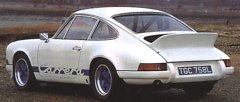 RS stands for Renn Sport. Many journalists regard it as the best 911 of all, mainly because of crispest handling. Porsche made this special edition for GT racing, therefore everything was lightweight. 2.7 litres pumped out 210 hp, enabling the 1-ton RS to out-perform many supercars. Ducktail rear spoiler as well as the name "Carrera" were used for the first time. Spec ; More details |
|
|
|
 The production 911 also got the 2.7 engine. The 911, now replaced 911T as the basic model, boosting 150 hp (re-rated to 165 hp later). Sport version 911S had 175 hp. The Carrera was basically a RS 2.7 but with more effective whaletail spoiler instead of ducktail and without as much weight-saving treatment. However, the biggest external change to these cars was the US-required 5-mph bumpers, which was successfully styled to make them looked more aggressive. |
|
|
|
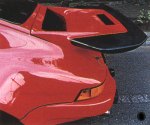  Again, to homologate Group 3 GT racing, Porsche built 106 units 911 RS 3.0. I believed I saw one of them in HK. It was evolved from the RS 2.7, with the engine bored out to a full 3 litres and capable of 230 hp. Wider rear fenders and whaletail spoiler added exotic appeal. As it was heavier and had larger frontal area than the 2.7 RS, it was actually no quicker. Spec |
|
|
|
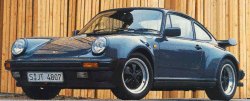 When Porsche assigned a new project number, 930, to a new 911, all insiders knew that it must be a revolutionary variant. Yes, it was the first turbocharged 911, one of the pioneers of turbocharging technology. It wasn't the first turbo road car, however, it was the first to succeed without unacceptable turbo lag and fuel consumption. Power and torque increased dramatically to 260 hp and 254 lbft, thus enable remarkable in-gear acceleration as well as top speed. However, thanks to more weight and full equipment, it was actually slower than the Carrera RS in the hands of good drivers. Spec ; More details |
|
|
|
After 6 years of absense, 912 was back with a 2-litre flat-4 pushrod engine came from Volkswagen. Again, it failed to be popular. |
|
|
|
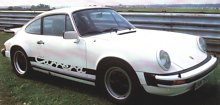 This one replaced the 2.7 litres Carrera. The 2994 c.c. engine was derived from the turbo 3.0, with the greener Bosch K-Jetronic mechanical injection, it output 200 hp or 10 less than the 2.7 unit. However, fuel economy and torque curve were improved. Spec |
|
|
|
  When 928 and 924 had been launched, Porsche's director Dr. Fuhrmann planned to reduce the production scale of 911. As a result, all 911s were replaced by a single model, 911SC, whose 3-litre engine was detuned to 180 hp probably intended to prevent it from having a higher top speed than the 928 (which was supposed to be the successor of 911). Although raised to 188 hp in '80 and 204 hp in '81, it was still relatively unremarkable. That was the darkest period in 911's 34 years history. Fuhrmann obviously intended to sacriface 911 to rescue his less-popular, overweight and expensive 928. Luckily, Ferry Porsche was still in favour of his brainchild so that he replaced Fuhrmann with American Peter Schutz. Since then the 911 resumed proper development. Spec |
|
|
|
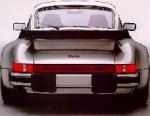 The
3-litre 930 turbo, though fast, did not impress journalists as much as
this 3.3 version. With 300 more c.c. and an intercooler, it output a
full
300 hp ! Capable to do 0-60 in at most 5.3 sec and top 160 mph. In
terms
of acceleration, no rivals could beat it until 1985. No wonder it could
be produced until 1990 without any major modifications. The
3-litre 930 turbo, though fast, did not impress journalists as much as
this 3.3 version. With 300 more c.c. and an intercooler, it output a
full
300 hp ! Capable to do 0-60 in at most 5.3 sec and top 160 mph. In
terms
of acceleration, no rivals could beat it until 1985. No wonder it could
be produced until 1990 without any major modifications.
Like the turbo 3.0, no 5-speed gearbox was capable to cope with its massive torque so that 4-speeder was used instead. The fifth ratio eventually came in 1989, thus cut 0-60 to a mere 4.9 sec. Spec ; More details |
|
|
|
Under Schutz's leadership, the first new 911 arrived. It was a cabriolet version of 911SC, also being the first Cabriolet version of 911.... |
|
|
|

.... however, the real new life started in here - the '83 Carrera was as exciting as the 911SC boring. Although now being the basic 911, Carrera's 231 hp 3.2 engine deserved the "Carrera" name - it could do 0-60 in 5.4 sec and top 150 mph ! Advanced Motronic management system accounted for the higher 10.3:1 compression ratio, hence higher efficiency. Spec |
|
|
|
While Dr. Fuhrmann prefered his tailor-made narrow-body 911 turbo, many customers liked this wide-body "turbo-look" Carrera. It did not offer better handling, just added 50 kg extra and more drag. You may call it a "poor" man's 911 Turbo, or a "fool"-man 911 Turbo is also appropriate. |
|
|
|
 This could be the most beautiful 911 to somebody - incorporated a 935-style "slant nose" with pop-up headlamps. Prepared by Porsche's "Special Requirement Department" for those asked for more power than the regular 911 turbo, the SE had 330 hp, 344 lbft and 170 mph top speed. Bigger turbo boost, larger intercooler and freer exhaust accounted for the power rise, but the deletion of recirculating valve (because no space left) deteriorated turbo lag. Believe or not, it was 80% more expensive than the regular turbo. |
|
|
|
 By deleting equipment, rear seat and sound insulation weighing about 100 kg, Porsche created a faster and crisper Carrera named "Club Sport" or simply CS. Keen drivers liked it very much. Autocar recorded 0-60 in 5.2 sec, a couple of tenth quicker than the regular Carrera. The test car weighed 1182 kg. |
|
|
|
 Inspired by 356 Speedster, the 911 also got Speedster's treatment - a cut-down windshield and a beautiful hood cover. Based on the 3.2 Carrera body but the "Turbo-Look" body was also available later. Not as water tight as Cabriolet though. |
|
|
|
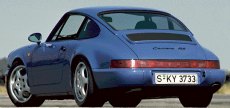 Again, a new project no. indicates this was a great step forward. The 964 Carrera 4 not only improved greatly on aerodynamics (via smooth bumper and auto rear spoiler) and engine flexibility, it also introduced the first ever 4-wheel drive system in 911, which transformed it into an understeerer ! Not everybody liked it though. New 3.6-litre engine output 250 hp with the help of twin sparks per cylinder and high compression ratio, offsetting the dramatic weight increase of 250 kg. Spec ; More details |
|
|
|
 Carrera 2 was the rear-wheel drive version of Carrera 4 with virtually no change in appearance. Without burdening by the 100 kg 4wd system, it became quicker and, more importantly, resumed the oversteer character that many enthusiasts buy 911 for. Spec ; More details |
|
|
|
From 1990, Tiptronic transmission, a Porsche-patented automatic transmission with manual override mode, became available in nearly all 911 versions. Very popular in big cities. More details |
|
|
|
Turbo was finally applied to the 964 body. Disappointingly, engine was still the 3.3 unit although with larger turbo and intercooler to boost 20 more horsepower from the previous 300 hp. As a result, 0-60 mph was cut down to 4.7 sec. Spec |
|
|
|
Not the best RS. Basically a stripped-out Carrera 2. 50 kg lighter, 40 mm lower ride height, stiffer suspension set up (therefore harsher), brakes came from Turbo. Engine remapped to 260 hp. |
|
|
|
 Before the launch of the 3.6-litre turbo, Porsche's racing department created a 3.3 turbo which was even quicker than the 3.6 turbo, that was the 911 turbo S. Through racing treatment (thinner glass, no much equipment, no rear seats, composite door / bonnet / engine lid, stiffer suspensions, lower ride height, extra cooling ducts at rear fenders, hotter cam and breathing, higher boost pressure etc.), it had specifications to amaze: 381 hp, 361 lbft and 1280 kg dry weight, or 190 kg lighter than a standard turbo. According to Paul Frere, it was quite difficult to drive and he prefered the Carrera RS. Only 81 cars were made to special orders. |
|
|
|
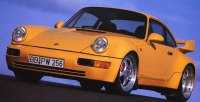 Soon
after the introduction of the 3.6 litres RS, Porsche decided to fully
participate
in German, FIA and Le Mans GT racing series. As a result, an even more
racy RS was born. Externally it differed from the 3.6 by wider
Turbo-look
body shell and biplane adjustable rear spoiler. Aluminium doors reduced
kerb weight by 10 kg. The bore was enlarged to 102 mm (remember the
original
911 2.0 was 80 mm?) thus displaced 3746 c.c. and pumped out a full 300
hp in road trim. Cylinder wall became so thin that the engine would not
be enlarged anymore. Harsh ride not suitable for road use. RSR was the
racing version installed with roll cage. A total of 100 RS plus RSR
were
made by Weissach. Soon
after the introduction of the 3.6 litres RS, Porsche decided to fully
participate
in German, FIA and Le Mans GT racing series. As a result, an even more
racy RS was born. Externally it differed from the 3.6 by wider
Turbo-look
body shell and biplane adjustable rear spoiler. Aluminium doors reduced
kerb weight by 10 kg. The bore was enlarged to 102 mm (remember the
original
911 2.0 was 80 mm?) thus displaced 3746 c.c. and pumped out a full 300
hp in road trim. Cylinder wall became so thin that the engine would not
be enlarged anymore. Harsh ride not suitable for road use. RSR was the
racing version installed with roll cage. A total of 100 RS plus RSR
were
made by Weissach. |
|
|
|
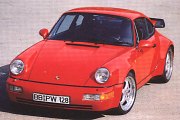 After
14 years of service, the 3.3 turbo engine was finally replaced by a 3.6
unit based on the Carrera 2/4's unit but with conventional single
spark.
Higher boost pressure and extra displacement resulted in 360 hp and
more
important, 383 lbft of torque. Now 0-60 took 4.5 sec. However, it
seemed
to be merely a stop-gap design without much breakthrough made - for
instance,
still without electronic boost control. Spec After
14 years of service, the 3.3 turbo engine was finally replaced by a 3.6
unit based on the Carrera 2/4's unit but with conventional single
spark.
Higher boost pressure and extra displacement resulted in 360 hp and
more
important, 383 lbft of torque. Now 0-60 took 4.5 sec. However, it
seemed
to be merely a stop-gap design without much breakthrough made - for
instance,
still without electronic boost control. Spec |
|
|
|
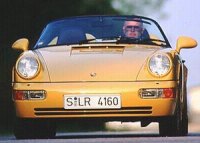 Again,
the Speedster came very late. This one based on 964 Carrera 2, which
was
to be replaced in the same year. Cut-down windscreen, hood cover, no
rear
seats ... very familiar, though no Turbo-Look available this time. As
the
new 993 was far more popular than 964, the Speedster died after less
than
1,000 built. Again,
the Speedster came very late. This one based on 964 Carrera 2, which
was
to be replaced in the same year. Cut-down windscreen, hood cover, no
rear
seats ... very familiar, though no Turbo-Look available this time. As
the
new 993 was far more popular than 964, the Speedster died after less
than
1,000 built. |
|
|
|
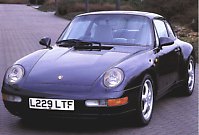 Project
993 introduced the biggest ever (also final) make-over to the 911 - the
most radical was changing the rear suspensions from semi-trailing arms
to multi-link, in addition to wider tracks, improved handling as well
as
ride a lot. The body received the first major facelift since the first
911, introducing smoother-looking body (if not reflected in drag
coefficient),
wider wheel arches, raised front bonnet (for more luggage space),
reduced
slope of windscreen etc., making it looked more modern and stylish.
Better
paint and fit and finish as well. 3.6 engine tuned to 272 hp and 243
lbft
by lightweight pistons and con-rods, further up to 285 hp and 251 lbft
in 1996 by introduction of Varioram variable intake manifold (first
seen
in 993 RS 3.8). 6-speed manual instead of 5, Tiptronic also got an
extra
gear, plus optional Tiptronic S with finger tip control on steering
wheel.
Carrera 4 used a simplified 4wd system, some regarded it even better to
drive (and feel) than the 2wd. 993 was a great success in terms of
sales
as well as reaction from motor journalists. Spec
; More details Project
993 introduced the biggest ever (also final) make-over to the 911 - the
most radical was changing the rear suspensions from semi-trailing arms
to multi-link, in addition to wider tracks, improved handling as well
as
ride a lot. The body received the first major facelift since the first
911, introducing smoother-looking body (if not reflected in drag
coefficient),
wider wheel arches, raised front bonnet (for more luggage space),
reduced
slope of windscreen etc., making it looked more modern and stylish.
Better
paint and fit and finish as well. 3.6 engine tuned to 272 hp and 243
lbft
by lightweight pistons and con-rods, further up to 285 hp and 251 lbft
in 1996 by introduction of Varioram variable intake manifold (first
seen
in 993 RS 3.8). 6-speed manual instead of 5, Tiptronic also got an
extra
gear, plus optional Tiptronic S with finger tip control on steering
wheel.
Carrera 4 used a simplified 4wd system, some regarded it even better to
drive (and feel) than the 2wd. 993 was a great success in terms of
sales
as well as reaction from motor journalists. Spec
; More details |
|
|
|
 No previous turbos followed so close to the development of the Carrera as this one. Twin-turbo gave this 3.6-litre unit 408 hp as well as far lighter turbo lag. Electronic boost control, larger intercooler and 6-speed box also played important roles. With Carrera 4’s 4wd system as compulsory, it was nearly as fast as the mighty 959, although it lacked the sharp steering feel as the Carrera. Huge grip and brake. The most accelerative production car then. Spec |
|
|
|
 911 RS was always a great driver's car, the last one was with no exception. Still using the 3.8-litre 300 hp 964 RS 3.8 engine but added with Varioram to boost low to mid range torque. The 993 basis provided far better handling. Compare with 993 Carrera, it got 18-in wheels instead of 16-in, front tower bar to stiffen sus geometry, adjustable anti-roll bar, Turbo-size brakes and carried 100 kg less weight (thanks to stripped-out cabin, aluminium bonnet and thinner glass). The most satisfying 911 since the original 911 RS 2.7. Club Sport and RSR versions got usual racing treatment including roll cage, aggressive front spoiler and biplane rear wing. Spec |
|
|
|
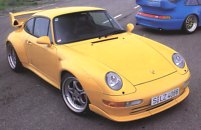 As
the FIA GT championship was established, Porsche entered a trio to take
on different class: 911GT1 (actually a race-developed car with little
relationship
to 911) targeted at the highest GT1 category, 911GT2 aimed at GT2 class
while 911 RSR raced in the lowest category GT3. As
the FIA GT championship was established, Porsche entered a trio to take
on different class: 911GT1 (actually a race-developed car with little
relationship
to 911) targeted at the highest GT1 category, 911GT2 aimed at GT2 class
while 911 RSR raced in the lowest category GT3.
911 GT2 was basically a stripped-out (1290 kg) and slightly more powerful (430hp) 911 turbo. The 200 kg weight reduction was achieved by taking away the 4wd system, all equipment and most sound insulation, plus rear seats and used thinner glass. Higher boost led to 22 hp more power. Aggressive front spoiler, biplane rear wing and replaceable wheel arch flares differed it from the regular Turbo. Only 50 road cars were built. Spec |
|
|
|
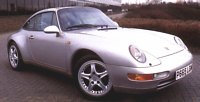 A 993 Carrera incorporated slidable "glass house" roof developed in conjunction with Mercedes. It added 30 kg but provided open-air fun combined with perfect refinement. |
|
|
|
Turbo-Look version of the 993. Wide body, big wheels and brakes all came from the Turbo, although small movable rear wing remained as the Carrera's. |
|
|
|
Finally, the real 911 retired after 34 years of service. Its successor, 996, was a completely new car linked closely with the Boxster. 996 borrows the great name "911" for marketing advantage. |
|
|
|
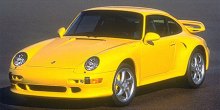 Before the 996 turbo appear in 2000, Porsche relied on the 993 turbo as its performance flagship. However, Porsche also launched an uprated 993 turbo for the US market in 1997, and then an even more powerful European version in Jan 1998, pumping out 424 hp and 450 hp respectively. Further finished with biplane rear wing and 959-like side air intakes. If you cannot distinguish it from other modified 911s, look at the unique yellow brake calipers.This was the fastest REAL 911, also the final version. Spec |
|
|
|
In
April 1998, the last Porsche 911 rolled out from Zuffenhausen factory.
Since 1963, a total of 401,232 units were produced, among which 32,335
cars were Turbo, 69,137 were the last generation - 993.
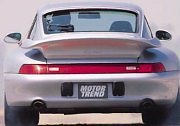 Bye Bye !! Bye Bye !! |